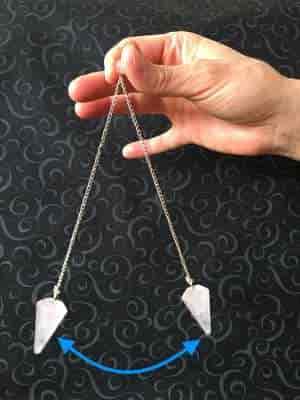Experiments in Dowsing
Learn dowsing using the pendulum
Test Your Dowsing Skills with a Pendulum
The pendulum is used widely by professional dowsers or water-diviners, who often prefer it to the divining rod. As well as its traditional use in detecting water or minerals, the pendulum is variously used to divine the sex of eggs or foetuses, to diagnose illnesses, or to find the locations of lost objects or people.
You can develop and test your own dowsing powers in the following experiments. You will need a simple pendulum which can be made by tying a finger ring or other small weight on a length of fine thread. About 12-18 inches (30-45cm) is fine.
To use the pendulum, hold the end of the thread lightly between the thumb and first two fingers of one hand. Your hand should be held comfortably at about shoulder height so that the ring hangs down freely.
The Experiments
Experiment 1

Hold the pendulum as described above. Now simply TELL the pendulum to move back and forth..
Do NOT try to make it swing by moving your hand - keep your hand still while staying relaxed.
You will find that the pendulum starts to move as directed, slightly at first and then with increasing amplitude (keep up the mental intention).
Now tell the pendulum to stop. The swing will quickly reduce until the pendulum stops moving.
Try telling the pendulum to move in different ways - e.g., left to right, diagonally, clockwise, anticlockwise. In each case the pendulum will move in the intended direction.
Practice these tests until you have developed a good sense of the ways in which the pendulum moves and the effects of your mental intentions on the movements.
Experiment 2
IMPORTANT: In this experiment, and the experiments that follow, it is important that you do NOT consciously intend any particular movement of the pendulum. You should rather simply WATCH the pendulum to see how it moves.
Ask a friend to hold out a hand and allow the weight to dangle just above it. You will find that the ring will start to move, apparently of its own volition.
You may find that the direction of movement is different depending on the sex of the person. It is often said, for example, that if the person is male the ring will swing back and forth, whereas if the person is female, the ring will trace a circle or ellipse. See if this is true for you.
Experiment 3
Think of a number between 5 and 10. Now hold the pendulum so that the weight hangs down inside a glass tumbler, without it touching the sides or bottom.
It may help to shorten the pendulum and rest your elbow on the table. The pendulum will start to swing until the ring strikes the side of the tumbler.
Mysteriously, the ring will continue to swing so that it strikes exactly the number of times you were thinking of, then it will slowly stop.
Experiment 4
Get three cups and invert them on a table.
While you turn away, ask a friend to hide a coin under one of the cups.
Now turn back and hold the pendulum over each of the cups in turn. From the movements of the pendulum, see if you can tell which cup the object is under.
Experiment 5
Try using the pendulum to get answers to questions that you are interested in. You will need to decide in advance what each direction of movement means.
A simple and sensible system is to use a forward-and-back swing for 'yes' and left-to-right for 'no'.
Alternatively, you can use clockwise for yes, and anti-clockwise for no. If you have a complex question, you will need to break it down into a sequence of yes-no questions. Have fun, but don't take it too seriously.
Comments
Of course, there is nothing 'magical' about the actual movements of the pendulum in any of these experiments.
The movements are caused by slight unconscious muscle movements in the body, arm and hand (if you don't believe this then, when observing someone else using the pendulum, watch their HAND rather than the pendulum).
Psychologists call this phenomenon the ideomotor response. The pendulum simply acts as an amplifier of these subconscious ideomotor movements, so that they can be more easily detected.
The interesting question in relation to the pendulum's use in dowsing is whether these unconscious muscular movements may be produced by super-sensory or extrasensory awareness. Experiments 4 and 5 provide a way of investigating these possibilities.
Further Reading
Dowsing (Wikipedia)
Bird, C. (2000). The Divining Hand: The 500-Year-Old Mystery of Dowsing.. Schiffer Publishing, Ltd.
Webster, R. (2012). Dowsing for Beginners: How to Find Water, Wealth and Lost Objects (Llewellyn's Beginners Series). Llewellyn Publications.
